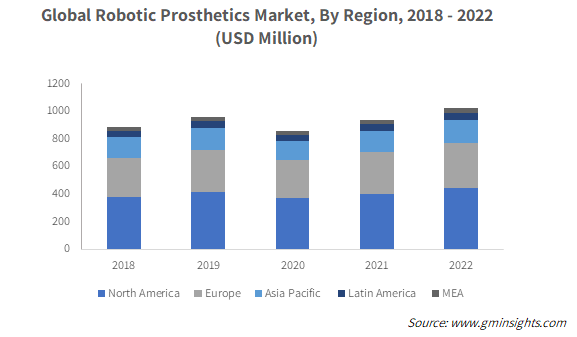Home > Healthcare > Medical Devices > Rehabilitation and Assistive Devices > Robotic Prosthetics Market
Robotic Prosthetics Market Analysis
- Report ID: GMI5430
- Published Date: Feb 2023
- Report Format: PDF
Robotic Prosthetics Market Analysis
Robotic prosthetics market valuation from microprocessor-controlled (MPC) prosthetics reached over USD 782 million in 2022. The surging demand for MPC prosthetics can be attributed to their advanced functional capabilities including the ability to monitor, switch, and adjust the control systems placed in the knee. For instance, in September 2022, AOTT published a study demonstrating the efficacy of microprocessor-controlled prosthetic knees (MPK) in patients with unilateral transfemoral amputations (TFAs) to ensure a better quality of life and locomotor capabilities. The growing emphasis on MPC prosthetics to improve patient recovery has fostered extensive R&D initiatives.
Robotic Prosthetics market from lower body prosthetics is projected to exhibit over 10.5% CAGR between 2023-2032. Lower body prosthetics such as the prosthetic ankle, prosthetic knee, and others are experiencing an upsurge in demand owing to the growing need for limb prosthetics among the aging geriatric population. Over the past few years, the number of individuals with peripheral artery disease (PAD) has increased significantly, driving the demand for prosthetics to treat issues with lower extremities. Globally, the number of PAD cases have surpassed 200 million and are estimated to continue to grow with the increasing geriatric population.
Robotic prosthetics market share from hospitals is anticipated to expand at 10.9% CAGR from 2023-2032. The emergence of novel diseases has compelled several governments to invest heavily in healthcare infrastructures and provide funds, allowing hospitals to procure next-generation medical technologies. Hospitals remain the primary center for healthcare among large populations due to better care infrastructure and convenient treatment. The increasing patient admission rates driven by the rising incidences of cancer, diabetes, and trauma will proliferate the demand for robotic prosthetics across hospital settings. Furthermore, hospitals worldwide are using cutting-edge prosthetics and robotic equipment to improve surgical and treatment output.

The robotic prosthetics market in Europe is poised to surpass USD 945 million by 2032. Europe is expected to emerge as a major hotspot for the robotic prosthetics industry with a massive footprint of key players and extensive R&D initiatives. For instance, in October 2022, the EU launched a new project, IntelliMan, aimed at developing a novel AI-powered manipulation technology for advanced robotic prosthetics, services, and manufacturing with an investment worth more than USD 4.8 million. A series of private and public fundings have been undertaken since, committing to the innovation and development of high-tech robotics with government backing.

